Modernizing Base Acres
TOPICS
USDA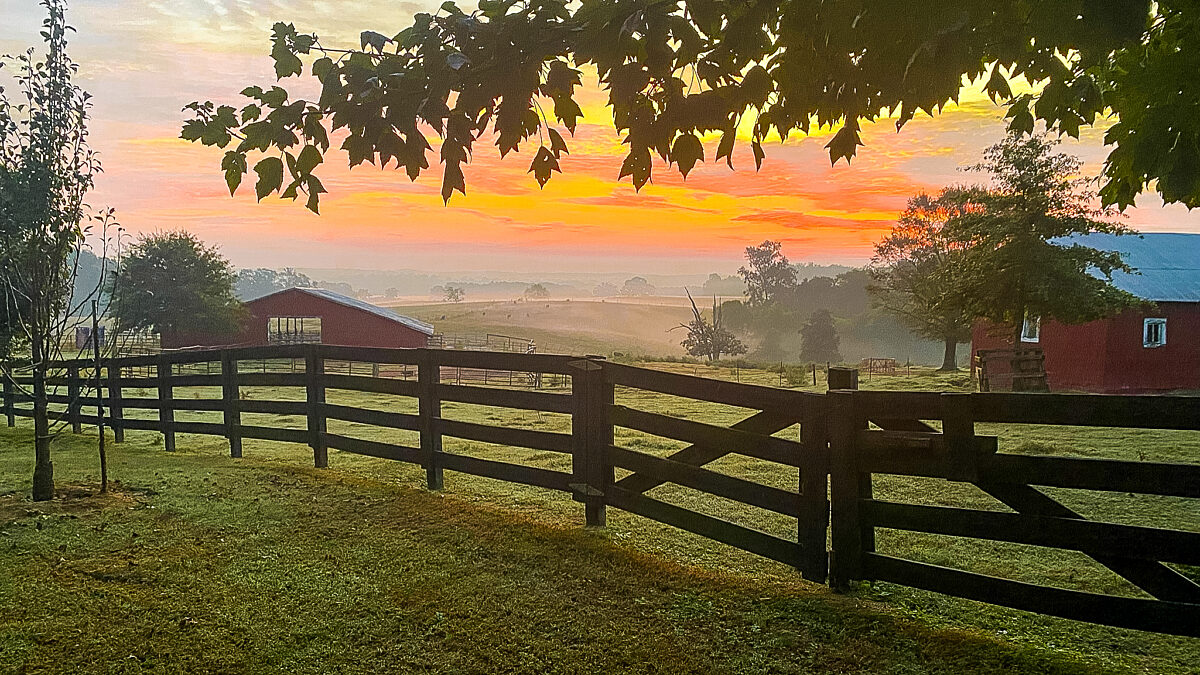
photo credit: AFBF Photo, Mike Tomko
Farm program payments are made based on historical planted acreage, i.e. base acres, not actual plantings, and therefore are not dependent on current production. This decoupling prevents farmers making annual planting decisions based on potential program payments, and instead allows market prices and expected returns per acre to influence planting decisions. With the 2018 farm bill process underway there is renewed interest in updating base acres relative to recent planting patterns. This article reviews the merits of a potential base acre modernization and maps the distribution of base acres relative to actual plantings during 2014 to 2017 on a commodity-by-commodity basis.
What Are Base Acres?
The 1996 farm bill decoupled farm program payments from actual planted acreage and instead made payments (not including crop insurance) based on a farm’s historical planted acreage. This decoupling provided significant planting flexibility that allowed farmers to plant program crops outside of their commodity-specific base and make annual planting decisions based on which crop provided the greatest expected return per acre.
Under current law, determining a farm’s program payment(s) is based on its historical base acres – even if those acres are not actually planted to that crop. Base acres are tied to the farm not the farm owner and represent the number of acres of a covered commodity eligible to receive program payments. Base acres were established in the 2002 farm bill and, up until the 2014 farm bill, mostly reflected planted acreage from 1998 to 2001.
The 2014 farm bill provided a voluntary one-time reallocation of base acres. Farmers with existing base acres were allowed to keep and then reallocate base acres to reflect covered commodities planted on the farm during the 2009 to 2012 crop years. Cotton base acres were converted to generic base acres and were the only acres coupled to actual planting decisions. A review of base acres and generic base acres is available on the following AFBF farm bill resources pages: Should we Update Bases and Yields? and Should Changes be Made to Generic Base Acres? Notably, during this reallocation opportunity no new base acres were created.
Following the 2014 farm bill reallocation, there were approximately 254 million base acres that were enrolled in a Title I commodity support program during 2015 and 2016. Covered commodities include corn, soybeans, wheat, rice, sorghum, peanuts and other minor field crops and oilseeds such as sunflowers and rapeseed. The distribution of base acres follows closely the distribution of U.S. cropland. Corn, soybeans and wheat represent 82 percent of all base acres with cotton (generic), peanuts and rice representing another 10 percent of base acres.
Payments Made on Base Acres
By decoupling planting decisions from farm program payments, the individual farm-level decision on which crops to plant each year is uncorrelated with the expected program payment. While decoupling has the benefit of minimizing the distortion of market signals, it can impact the ability of farm program payments being directly applied to the commodities and farmers experiencing a downturn in their market prices or revenue.
The economic implications of making farm program payments on historical acres include the potential for program payments to be made on acres where certain crops are no longer grown or have been shifted to other crops. Farmers not receiving program payments because they are producing a commodity without base acres assigned to the farm is also a problem
As evidence, consider that during the 2014 and 2015 crop years, U.S. farmers planted an average of 56 million acres of wheat, but USDA made program payments totaling $1.5 billion on 62 million base acres of wheat. Similarly, U.S. farmers planted 90 million acres of corn during 2014 and 2015 and received $7.9 billion in program payments on 95 million base acres.
In contrast, U.S. farmers planted 81 million acres of soybeans during 2014 and 2015, yet program payments totaling $1.3 billion were made on only 54 million base acres. With record soybean acreage planted in 2017, many of these acres will not have soybean-specific commodity program support should prices or revenue decline.
Changing Landscape of Crop Production
While program payments are based on historical plantings, significant changes in the allocation of cropland have been experienced since program payments were first decoupled. For example, in 2017, U.S. farmers are expected to plant 29 million more soybean acres and 25 million fewer wheat acres than in the five-year period prior to the 1996 farm bill. Since 1996, acreage has shifted out of wheat, cotton, rice and other minor field crops, and into soybeans, corn and peanuts, Figure 1.
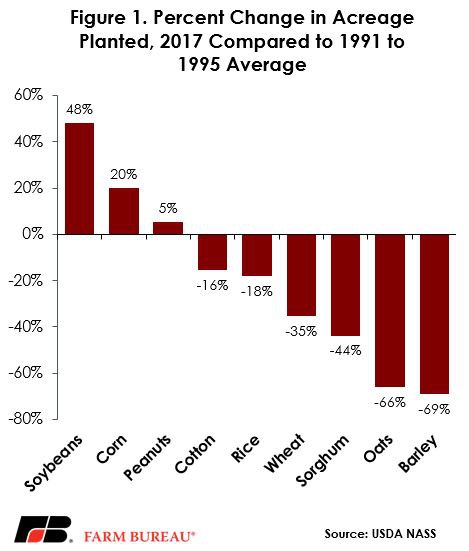
Of the nine crops identified in Figure 1, on average from 1991 to 1995 farmers planted 251 million acres, and in 2017 farmers are projected to plant 253 million acres to these crops. It’s clear that total planted area remains consistent. What’s occurred is crop production has responded to market signals and reallocated at both the commodity and regional levels. The increased demand for soybeans from China and for advanced biofuels, and for corn-based ethanol has driven an expansion in the production of these crops in areas where they were not historically grown -- likely at the expense of other commodities.
In addition to changes in cropland allocation, the intensity of crop production has also changed. For example, since 1996, cotton acreage in Texas has increased 880,000 acres while cotton planted in the Mississippi Delta and California has declined by more than 2 million acres. The additional cotton acres that have come online in Texas may not have historical cotton base acres (now generic base) while the former cotton acres now planted to another crop in the Delta and California may continue to have, and receive program payments on, these base acres. Figures 2 through 9 highlight the difference between historical base acres, as allocated in the 2014 farm bill, and average actual plantings from 2014 to 2017 in total and individually for corn, soybeans, wheat, sorghum, rice, cotton and peanuts.
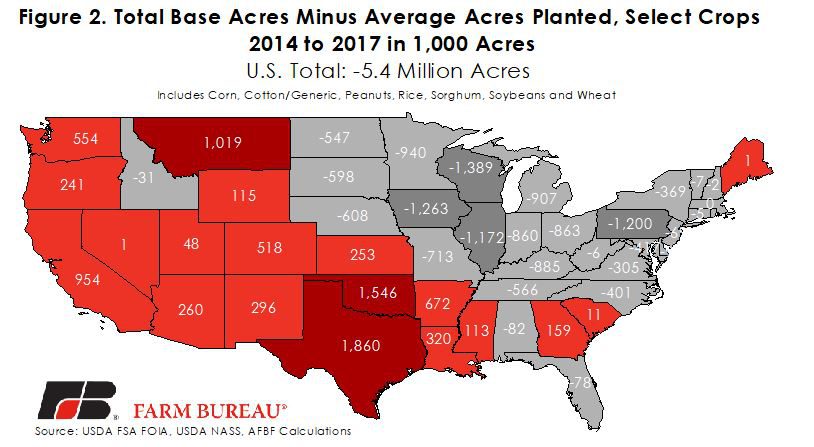
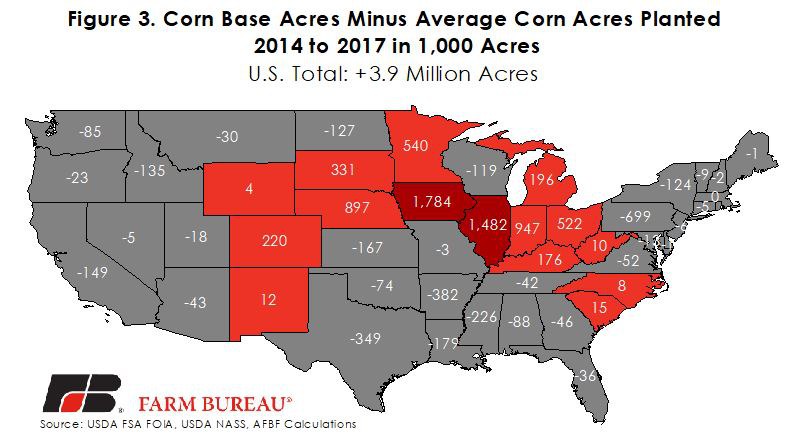
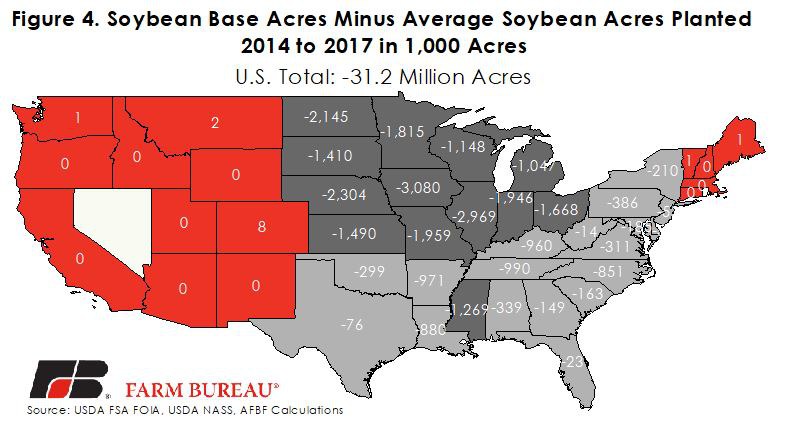
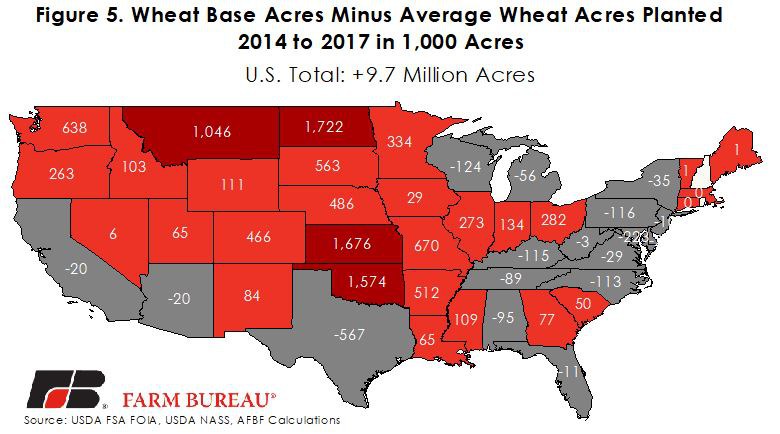
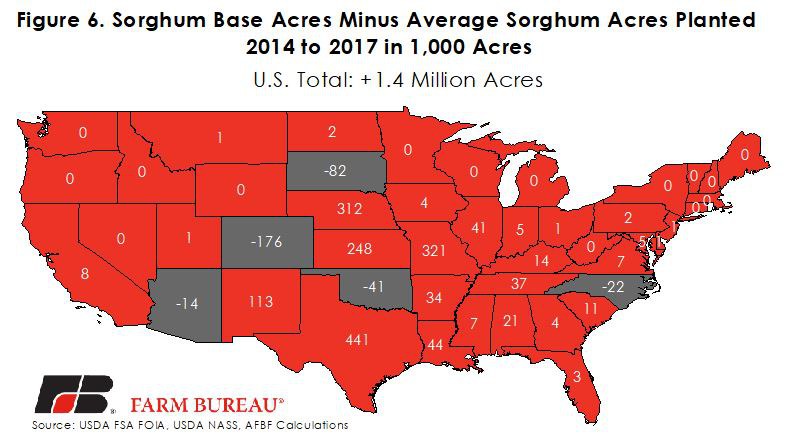
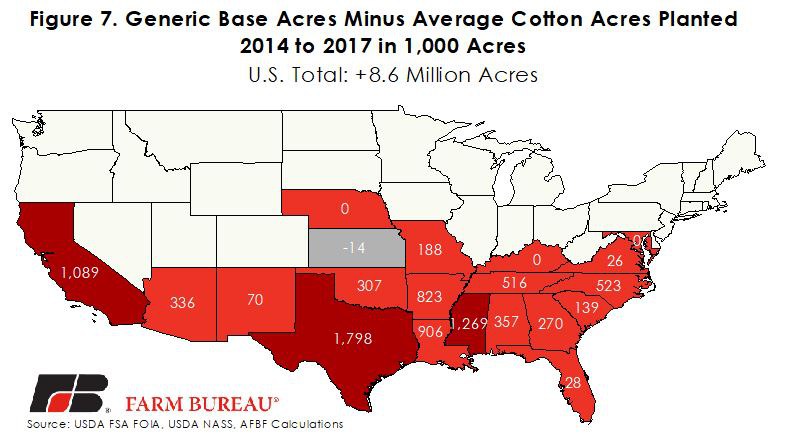
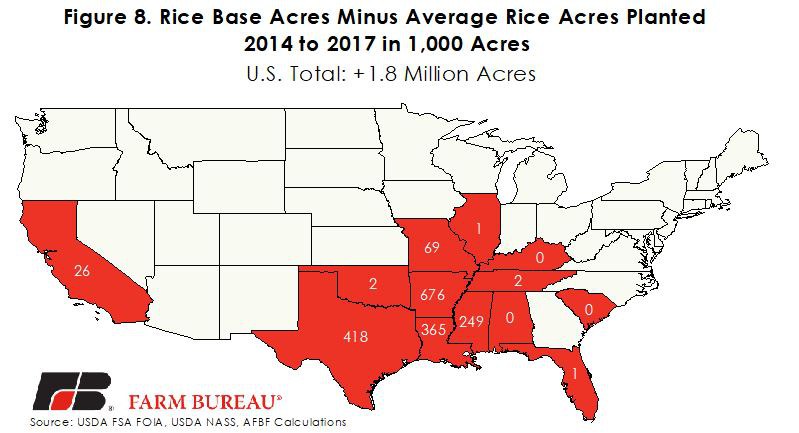
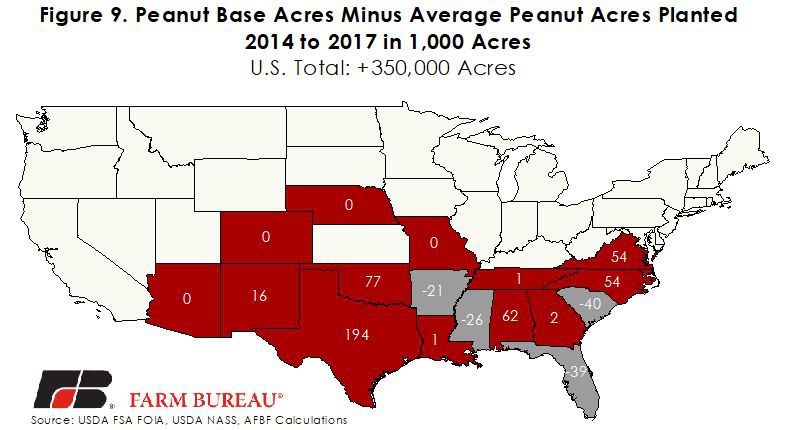
As demonstrated in Figures 2 to 9 there are many areas and crops for which base acres do not align with actual planting patterns. Red shaded states have more base acres than average actual plantings, while grey shaded states have fewer base acres the average actual plantings. Of the seven crops highlighted, all of them have more base acres than average plantings, except for soybeans. These differences are in large part due to farmers reallocating base acres in 2014.
Implications
This shift in acreage and the regional reallocation of crop production has implications for the effectiveness of farm program payments in managing risk. The ability of Title I safety net programs to protect farmers during a prolonged decline in commodity prices may be diminished when payments do not align with the farmers or regions where the commodity is produced. Commodity program payments that are made may be uncorrelated with the crops and risk experienced on the farm.
Additionally, no risk management protection is provided on acres converted from livestock or pasture into crop production or for farmers farming on land without base acres– some of whom are young and beginning farmers. The lack of Title I commodity safety net support for beginning lands, new farmers or land recently converted into covered commodity production may put some growers at a competitive disadvantage compared to farmers with base acres who also receive program payments.
To address these issues there is a renewed discussion on the merits of a modernization to base acres to reflect recently planted area. Importantly, a base acre modernization is unlikely to change the total number of acres eligible for farm program payments given that planted acres and base acres of covered commodities are both near 250 million acres. Rather, a modernization would change the distribution of base acres and farm program payments among farmers.
The economic implications of reallocating base acres needs to be examined and debated in more detail by Farm Bureau grassroots members, policymakers and industry stakeholders. American Farm Bureau supports voluntary, not mandatory, updating of base acres in the next farm bill and also supports continuing to base commodity program payments on historic, rather than planted, acres.
